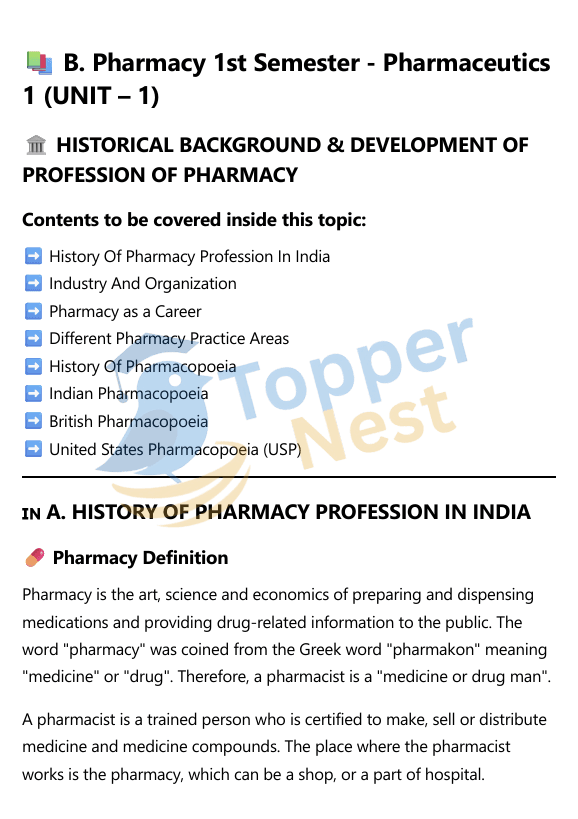Pharmaceutics is the foundation of pharmacy, bridging the gap between drug discovery and drug use. This unit introduces students to the historical evolution of pharmacy in India, dosage forms, prescriptions, and posology—laying the groundwork for future studies and practical applications in pharmacy practice.
Historical Background and Development of Pharmacy in India
Pharmacy in India has evolved significantly over the past century. The development began during British rule and gained momentum post-independence with the formation of professional bodies and educational institutions.
Key Milestones:
- Pharmacy Education: The first pharmacy college in India was established in 1937 at Banaras Hindu University (BHU). Today, the PCI (Pharmacy Council of India) regulates pharmacy education.
- Pharmaceutical Industry: India became self-reliant in drug manufacturing after the Indian Patent Act of 1970, now known as the “Pharmacy of the World.”
- Pharmaceutical Organizations: Establishments like IPGA, IPA, and AIOCD have played major roles in industry growth and regulation.

Introduction to dosage forms
In pharmaceutical science, a dosage form is the final physical form in which a drug substance (the active pharmaceutical ingredient or API) is presented to a patient. It’s the mechanism by which drug molecules are delivered to their intended site of action within the body to produce a desired therapeutic effect.
A pure chemical drug substance is rarely administered directly. It is instead formulated with various non-medicinal components, known as excipients, to create a specific dosage form.
Why are Dosage Forms Necessary?
The need for dosage forms arises from several critical factors:
- Accurate and Safe Dosing: Dosage forms allow a precise, single dose of a drug to be administered, which is crucial for safety and efficacy. Many potent drugs are only needed in very small quantities (milligrams or micrograms), which would be impossible for a patient to measure on their own.
- Protection and Stability: They protect the drug from external factors that could degrade it, such as atmospheric oxygen, moisture, and light. For example, coated tablets or sealed ampoules prevent degradation.
- Taste and Odor Masking: Many drug substances have a bitter, salty, or otherwise unpleasant taste and smell. Dosage forms like coated tablets, capsules, or flavored syrups effectively mask these undesirable characteristics, improving patient compliance.
- Protection from Gastric Environment: For drugs that are unstable in the acidic environment of the stomach, special dosage forms like enteric-coated tablets are used. These are designed to pass through the stomach intact and release the drug in the more alkaline environment of the intestines.
What is Prescription?
A prescription is a written order from a licensed healthcare professional (such as a doctor, dentist, or veterinarian) to a pharmacist. It authorizes the pharmacist to dispense a specific medication, medical device, or other health-related product to a patient. In essence, it’s the critical link between the clinician’s diagnosis and treatment plan, and the patient’s access to the prescribed therapy.
Types of Prescriptions:
- Written Prescriptions: The traditional paper-based format.
- Oral (Verbal) Prescriptions: Given over the phone to the pharmacist. These are typically transcribed and verified by the pharmacist, often requiring a follow-up written or electronic prescription.
- Electronic Prescriptions (e-Prescriptions): Sent directly from the prescriber’s electronic health record (EHR) system to the pharmacy’s dispensing system. This is becoming the standard due to improved efficiency, security, and reduced errors.
Definition of Posology
Posology is the branch of medical and pharmaceutical science that deals with the study of drug dosages. It is concerned with determining the appropriate dose or quantity of a drug that should be administered to a patient to produce the desired therapeutic effect while minimizing the risk of adverse side effects or toxicity.
FAQs – Pharmaceutics Unit 1
1. What is the role of pharmacopoeias in pharmacy?
Pharmacopoeias serve as legal standards for drug quality, strength, and purity in manufacturing and clinical practice.
2. Why are dosage forms important?
They ensure accurate dosing, enhance patient compliance, and determine the route of administration and drug stability.
3. What causes prescription errors?
Common causes include poor handwriting, unclear instructions, or wrong abbreviations used by prescribers.
4. Which method is best for pediatric dose calculation?
The Body Surface Area (BSA) method is most accurate but requires height and weight; Young’s and Clark’s rules are simpler for quick estimates.
5. What is the difference between IP and USP?
IP is specific to India, while USP is used primarily in the US and internationally. Both have similar purposes but may differ in formulations, tests, and drug monographs.
